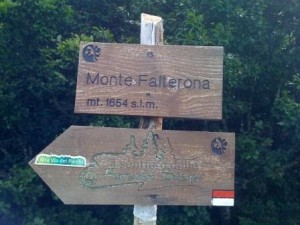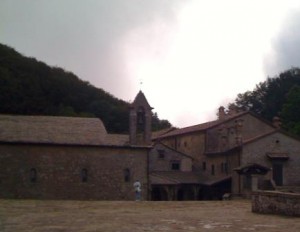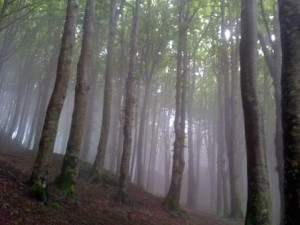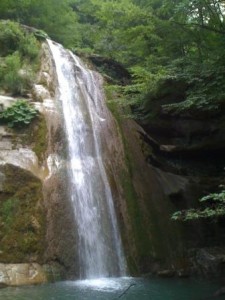 Wandering through chestnut forests, cresting hills and scrambling down ravines, resting near patches of wild blueberries: hiking is a wonderful way to travel with family–especially with teenagers. In the Apennine Mountains an old pilgrimage route connected Byzantine Ravenna with central Italy, and ultimately Rome. It is now part of a trail through the Casentine Forest National Park; modern hikers and pilgrims can explore natural and historical sites in this beautiful, wild region.
Wandering through chestnut forests, cresting hills and scrambling down ravines, resting near patches of wild blueberries: hiking is a wonderful way to travel with family–especially with teenagers. In the Apennine Mountains an old pilgrimage route connected Byzantine Ravenna with central Italy, and ultimately Rome. It is now part of a trail through the Casentine Forest National Park; modern hikers and pilgrims can explore natural and historical sites in this beautiful, wild region.
Our family followed a path from La Verna to San Benedetto in Alpe, traveling north for six days. Well-marked with signs and blazes, the trail can be walked in sections with lodging at the end of each day, alleviating the need to carry tents or sleeping bags. Several books, websites and Park Service resources list walking itineraries with maps, historical sites and guesthouses, and it can all be booked online.
From Rome we boarded a train to Arezzo, and then a taxi to the Sanctuary of La Verna atop Mount Penna. A Franciscan Monastery dating from the 11th century, the complex is surrounded by forest. St. Francis of Assisi received stigmata here, and it has long been a place of pilgrimage. We stayed in the guest quarters and ate our meals in a hall with other pilgrims, tourists and walkers. In the morning we left through the front gate under the sign ‘Non est in toto sanctior orbe mons’ (The world has no more saintlier mount) and walked down the old mule trail toward the town of Rimbocchi.
 The Casentine Forest reaches its summit on a ridge between Tuscany and Emilia Romagna, at the top of Monte Falterona. We walked through stands of oak, hornbeam, beech, white fir and chestnut trees, depending on the soil and elevation. Wolf, owl, boar, eagle, deer, badger and red fox live in the park, along with wild mushrooms and blueberries. During six days we saw a few other hikers and locals, but most of the time we were alone. Near the ridge we crossed a trail called the Alta Via dei Parchi, a 500 kilometer stretch of land passing through seven national parks.
The Casentine Forest reaches its summit on a ridge between Tuscany and Emilia Romagna, at the top of Monte Falterona. We walked through stands of oak, hornbeam, beech, white fir and chestnut trees, depending on the soil and elevation. Wolf, owl, boar, eagle, deer, badger and red fox live in the park, along with wild mushrooms and blueberries. During six days we saw a few other hikers and locals, but most of the time we were alone. Near the ridge we crossed a trail called the Alta Via dei Parchi, a 500 kilometer stretch of land passing through seven national parks.
On the third day of the hike we arrived at the ancestral seat of the Camaldolese monastic order, founded around 1012 by St. Romuald. The Holy Hermitage is enclosed by rock walls and contains individual cells, a church and library. Here monks live a solitary life of prayer and work, while in the nearby monastery they live in community. Historically they were responsible for managing and protecting the adjacent forest, and we walked downhill through vast, silent groves of silver fir trees. The Camaldoli complex; church, library and guesthouse, is built on the banks of the Archiano River. The monastery surrounds a lovely cloister with two rows of arches resting on columns. The old pharmacy where monks studied and prepared herbal medicines is open for tours, and the new pharmacy sells modern salves, local liquors and excellent chocolate bars.
 We continued our walk to the village of Castagno d’Andrea. Every night we stayed in mountain refuges, BnBs or guest houses along the route, and arrived to find clean beds and local food: handmade pastas, roasted meats, wine. Breakfasts were ample, and we were given packed lunches daily. Our hosts were interesting, often generous people, willing to speak a mix of Italian, English and charades if necessary. We learned about truffle hunting dogs, wild-boar ragu, and how to read a map carefully.
We continued our walk to the village of Castagno d’Andrea. Every night we stayed in mountain refuges, BnBs or guest houses along the route, and arrived to find clean beds and local food: handmade pastas, roasted meats, wine. Breakfasts were ample, and we were given packed lunches daily. Our hosts were interesting, often generous people, willing to speak a mix of Italian, English and charades if necessary. We learned about truffle hunting dogs, wild-boar ragu, and how to read a map carefully.
On the last day of the trail we descended from the ridge and passed a roaring waterfall mentioned by Dante in the 16th canto of his Inferno. Still a source of wonder, we saw crayfish in the pool and rested by the banks of the river. A mile above the town of San Benedetto in Alpe sits the Abbey of Saint Benedict, founded by St. Romuald around the year 1000. We had arrived at the end of our walk; nearly 70 kilometers of beautiful forest, and an unforgettable family vacation.
 Sacred Forests
Sacred Forests
A Trail through the National Park of the Casentine Forests amidst Nature and Spirituality. 2008. Parco Nazionale delle Foreste Casentinesi, Monte Falterona e Campigna, Giunti Publishers.
Author Kiki McGrath is a Washington, DC, artist who lived in Rome with her family for many years and returns to Italy in the summer as a guest artist for the Arte al Sole summer children’s art programs in Tuscany and other locations.
 Add to favorites
Add to favorites
Connect